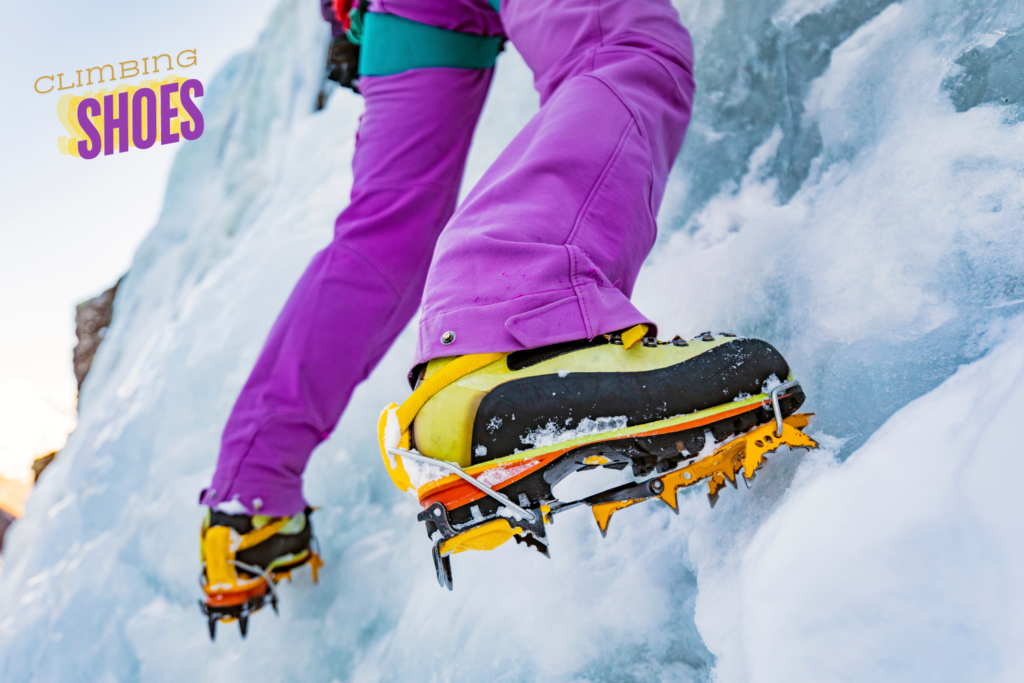Climbing shoes are a climber’s most vital piece of gear, providing the connection between your body and the rock. Properly maintained, they can significantly enhance your performance. However, even the best climbing shoes won’t last forever, especially with frequent use. This is where resoling comes in—a cost-effective way to extend the life of your beloved shoes. But when should you resole your climbing shoes? This guide will walk you through the signs, timing, and process to help you make the most out of your climbing footwear.
Understanding the Anatomy of Climbing Shoes
Before diving into resoling, it’s essential to understand the key components of climbing shoes and how they wear over time:
- Outsole: The rubber sole that makes contact with the rock. It provides the grip and friction necessary for climbing. This is the part that is typically resoled.
- Rand: The rubber that wraps around the toe box and sides of the shoe, offering protection and additional friction.
- Midsole: The layer between the outsole and the insole, providing structure and support.
- Upper: The material (often leather or synthetic) that wraps around your foot, giving the shoe its shape and fit.
Each part of the shoe wears out differently, depending on your climbing style, the types of surfaces you climb on, and how frequently you climb.
Signs It’s Time to Resole Your Climbing Shoes
The timing of a resole is crucial. Resole too late, and you risk damaging other parts of the shoe, making a repair either more expensive or impossible. Here are the key indicators that it’s time to resole your climbing shoes:
- Visible Wear on the Outsole:
- The most obvious sign is when you notice thinning of the rubber outsole, especially at the toe and along the edges. This is where most climbers wear their shoes down due to the pressure applied during climbs.
- If you can see the rand (the rubber wrapping around the toe box) through the outsole, it’s definitely time to resole.
- Flat Spots or Balding:
- If certain areas of the rubber have become smooth or “bald,” it indicates significant wear. These flat spots reduce friction and can severely impact your climbing performance.
- Rand Damage:
- If the wear on the outsole has progressed to the point where the rand starts to wear through, it’s a sign you’ve waited too long. At this stage, resoling can still be done, but it will likely involve a more extensive repair.
- Loss of Edging Precision:
- When the shoe’s edges round off and you start losing precision on small footholds, it’s a sign that the rubber has worn down enough to warrant a resole.
- Changes in Fit and Feel:
- As the rubber wears down, the shoe can start to feel looser or less supportive. If you notice a significant change in how the shoe feels during climbs, it might be time to consider resoling.
The Best Time to Resole: Timing is Everything
Resoling at the right time can extend the life of your shoes significantly. Here’s how to determine the best timing:
- Early Detection:
- The earlier you detect signs of wear, the better. Regularly inspect your shoes after each climb. Look for thinning rubber, especially around the toe and edges.
- Resoling before the rand is damaged is ideal, as it’s a simpler and cheaper process. If you wait until the rand is worn through, you may need a rand repair in addition to resoling, which is more expensive.
- Frequency of Climbing:
- If you’re a frequent climber, say three to five times a week, you might need to resole every six months. For weekend warriors who climb less frequently, once a year might suffice.
- Keep in mind that climbing on rougher surfaces, like outdoor granite, wears down rubber faster than climbing in a gym.
- Type of Climbing:
- Bouldering tends to wear out the toes and edges faster due to the more aggressive, dynamic moves. Sport climbing and trad climbing might wear out shoes more evenly, but the time frame for resoling remains similar.
Choosing the Right Resole Service
Not all resoling services are created equal. Choosing a reputable resole service can make a significant difference in the longevity and performance of your shoes. Here are some factors to consider:
- Reputation and Reviews:
- Look for resole services with positive reviews from other climbers. Word-of-mouth recommendations from your local climbing community can also be valuable.
- Check if the service is known for maintaining the shape and integrity of the shoe after resoling.
- Rubber Options:
- Many resoling services offer different types of rubber with varying thicknesses and stickiness. The most common options include Vibram XS Grip, Five Ten Stealth, and La Sportiva’s proprietary rubber.
- Choose the rubber that best matches your climbing style. For example, softer rubber provides better friction but wears out faster, while harder rubber is more durable but might not grip as well on certain surfaces.
- Additional Repairs:
- If the rand or other parts of your shoe are damaged, ensure the resole service can handle these repairs. Some services also offer midsole replacements or custom adjustments.
- Turnaround Time:
- Depending on the season and demand, turnaround times can vary. Some services offer expedited options, but they may come at an additional cost.
Resoling Process: What to Expect
Once you’ve decided to resole your shoes and chosen a service, here’s what you can typically expect from the process:
- Shipping and Initial Inspection:
- You’ll send your shoes to the resole service, either through mail or by dropping them off if they’re local.
- The service will inspect your shoes and may contact you if there are additional repairs needed beyond the standard resole.
- Rubber Removal:
- The old rubber outsole is carefully removed without damaging the shoe’s upper or midsole.
- Rand Repair (if necessary):
- If the rand is worn through, it will be repaired or replaced. This involves adding a new layer of rubber around the toe area.
- New Rubber Application:
- New rubber is applied to the outsole, shaped, and trimmed to match the original design of the shoe. The shoe is then heated to ensure a strong bond between the new rubber and the existing shoe.
- Quality Check and Shipping:
- After the new rubber has been applied, the shoes undergo a quality check to ensure the resole was successful. The shoes are then shipped back to you.
Extending the Life of Your Climbing Shoes Post-Resole
Once your shoes are resoled, there are steps you can take to maximize their lifespan and delay the need for another resole:
- Proper Storage:
- Store your shoes in a cool, dry place away from direct sunlight. Avoid leaving them in a hot car, as excessive heat can degrade the rubber and the glue used in the resole.
- Regular Cleaning:
- Clean the rubber soles regularly to remove dirt and debris that can reduce friction. A simple wipe with a damp cloth after each climb can go a long way.
- Avoid washing your shoes in a machine, as this can damage the material and shape.
- Mindful Climbing:
- Be conscious of your footwork. Dragging your feet or scraping them unnecessarily can accelerate wear. Practicing precise foot placements can help your shoes last longer.
- Rotate Between Pairs:
- If you climb frequently, consider rotating between two pairs of shoes. This allows each pair time to recover, especially if you’re alternating between different types of climbing.
When to Retire Your Climbing Shoes
Even with resoles, there comes a time when a pair of climbing shoes reaches the end of its life. Here are some signs that it might be time to retire your shoes:
- Excessive Upper Damage:
- If the upper material is torn, stretched beyond repair, or separating from the sole, it might be time to retire the shoes.
- Compromised Fit:
- If the shoe no longer fits well or feels supportive even after a resole, its structure may be too compromised to continue using.
- Repeated Rand Damage:
- If you’ve had the rand repaired multiple times and it continues to wear through quickly, it might indicate that the shoe’s overall integrity is too compromised.
- Loss of Shape:
- Over time, climbing shoes lose their original shape and structure, which can affect performance. If your shoes have become too soft or misshapen, they might not be worth another resole.
Conclusion:
Resoling is a practical way to extend the life of your climbing shoes, save money, and maintain your performance on the wall. By paying close attention to the signs of wear and acting promptly, you can ensure that your shoes are always in top condition, ready for the next climb. Remember, the key to maximizing the lifespan of your climbing shoes lies in early detection, choosing a quality resole service, and taking care of your shoes post-resole. With these practices, you can keep your trusted climbing partners around for many more adventures to come.
FAQs:
1. How many times can I resole my climbing shoes?
You can typically resole climbing shoes two to three times, depending on the condition of the shoe and how well the previous resoles were done. If the upper and rand are in good shape, additional resoles are possible, but the shoe’s overall structure will eventually wear down, making further resoles less effective.
2. How much does it cost to resole climbing shoes?
The cost of resoling climbing shoes generally ranges from $40 to $80, depending on the type of rubber used, the complexity of the repair, and whether additional repairs like rand replacement are needed. Prices may vary by service provider and region.
3. Can all types of climbing shoes be resoled?
Most climbing shoes, whether for bouldering, sport climbing, or trad climbing, can be resoled. However, shoes with complex constructions, like those with integrated midsoles or aggressive downturns, may require specialized resoling services. Always check with the resole provider to ensure they can handle your specific type of shoe.
4. How long does a resole take?
The turnaround time for a resole can vary depending on the service provider and the time of year. Typically, it takes between 1 to 4 weeks, with some providers offering expedited services for an additional fee. It’s advisable to check with the provider about their current lead times before sending in your shoes.
5. Will resoling my shoes change their performance?
A well-done resole should maintain the original performance of your shoes. However, there may be a short break-in period as the new rubber conforms to your foot and climbing style. If the shoes are resoled with a different type of rubber, the feel and grip may differ slightly, but most climbers adjust quickly.

